|
|
|
It's
A Cup Final Knockout 1972
British Domestic Series
Presenters:
Stuart Hall
Eddie Waring Referee:
Arthur
Ellis
Scoregirls:
Glynne Geldart
Jean Galston
Tricia
O'Donnell
Laura Sutcliffe
Production Credits:
Production Team: Geoff Wilson and Alan Wright;
Engineering Manager: Geoff Lomas;
Sound: John Drake;
Designer and Games Deviser: Stuart Furber;
Producer: Barney Colehan; Director: Bill Taylor
A BBC Manchester Production
|
Key:
Domestic Special
● =
Winner of Special
▲ = Promoted to Position / ▼ =
Demoted to Position |
|
|
GB |
It's
A Cup Final Knockout 1972 |
FA
Cup Final Special |
|
Event Staged: Sunday 23rd April 1972 from 5.30pm
Venue:
Congleton Park, Congleton, Cheshire
Transmission:
BBC1 (GB): Saturday 6th May 1972, 12.55-1.40pm (as part of Cup Final Grandstand)
Celebrity Supporters (non-participating):
Arsenal F.C. - Henry Cooper (boxer) and George Eastham (Stoke City
player)
and Pete Murray
(BBC Radio 2 DJ);
Leeds United F.C. - Gordon Banks (Stoke City player), Billy Bremner,
Jack Charlton and Johnny Giles (Leeds
United players), Ronnie Hilton (singer) and Don Revie (Leeds United manager). |
|
Teams:
Arsenal F.C. v. Leeds United F.C. |
|
Games: Let It Go to Your Head, Seesaw Dribble, Hit the Holes, Would You
Like Chips with That?, Shoot the Hoops, Spinning Shots and Pass Me the Ball! |
|
Game
Results and Standings |
|
Result |
Team |
Points |
|
1st
2nd |
Leeds United F.C.
●
Arsenal F.C. |
10
8 |
|
The Host
Town |
|
Congleton, Cheshire
Congleton is a town with a population of around 28,000 inhabitants and
lies on the banks of the River Dane in the county of Cheshire. It is located
11 miles (18km) north of Stoke-on-Trent, 22 miles (35km) south of Manchester,
28 miles (45km) east of Chester and 33 miles (54km) east of Chesterfield.
Following King Edward I (1239-1307) granting permission to build a mill, the
town became an important centre of textile production, notably of leather
gloves and lace. In 1451, the River Dane flooded, destroying a number of
buildings and the town’s wooden bridge and mill. The river was then diverted
and the town rebuilt on higher ground.
As
time passed, further mills were established including an early silk throwing
mill and what became known as the Old Mill built by John Clayton and Nathaniel
Pattison in 1753. The town's prosperity depended on tariffs imposed on
imported silk. When tariffs were removed in the 1860s, the empty mills were
converted to fustian (a heavy cotton cloth) cutting. A limited silk ribbon
weaving industry survived into the 20th century, and woven labels were still
produced in the 1990s. Many of the mills survive today as industrial or
residential units.
The
principal industries in Congleton today include the manufacture of airbags and
golf balls. There are light engineering factories near the town, and sand
extraction occurs on the Cheshire Plain, although much of the town is now a
dormitory for Manchester and Stoke-on-Trent. The Macclesfield Canal, completed
in 1831, passes through the town. It runs 26 miles (42km) from Marple, where
it joins the Upper Peak Forest Canal, southwards (through Bollington and
Macclesfield), before arriving at Bosley. Having descended the 12 Bosley Locks
over the course of about one mile (1.6km), the canal continues through
Congleton to a junction with the Hall Green Branch of the Trent and Mersey
Canal at Hall Green. The canal is renowned for its elegant roving bridges,
locally known as 'Snaily Bridges'. Congleton is one of few places in Britain
where a road, canal and railway all cross each other at the same place.
Congleton became notorious in the 1620s, when bear-baiting, as well as
cockfighting, were popular sports. The town was unable to attract large crowds
to its bear-baiting contests and lacked the money to pay for a new, more
aggressive bear. A solution was found when money set aside to purchase a bible
for Congleton was used to buy such a beast - and the increased income
generated by the spectators who then flocked to the town went to replenish the
fund. It became legend that Congleton sold its bible to pay for a new bear and
is celebrated in the chorus of 20th century folk song Congleton Bear,
by folk artist John Tams, which runs “Congleton Rare, Congleton Rare, Sold the
Bible to buy a bear”. The town’s nickname of 'Beartown' was the consequence of
this legend and the logo of the local brewery, Beartown, bears (excuse
the pun) the words to the song and the town’s football team, Congleton F.C.
are nicknamed The Bears and has a performing chained bear as part of its
official club badge.
|
This It's A Cup Final Knockout special was held during the weekend
festivities celebrating the 700th anniversary of the town of Congleton
being granted its first charter in 1272. This charter enabled the town to
hold fairs and markets, elect a mayor and ale taster, have a merchant
guild and behead known criminals. |
|
|
The Visiting Clubs |
|
Arsenal Football Club was founded in 1886 and plays its home matches at
the Emirates Stadium and is located 142 miles (229km) south-east of Congleton.
Leeds United Football Club was founded in 1919 and plays its home
matches at Elland Road and is located 50 miles (80km) north-east of Congleton. |
|
The Venue |
|
Congleton Park
The games were played at Congleton Park which was opened in 1871. Following a
movement to create public parks in the 19th century, the Town Council bought
twelve acres of land between Town Wood and the River Dane in 1856, with the
object of creating an open space in which to lay out a public park. A park
committee was appointed but seemingly they needed reassurance about the site.
One advisor to whom they applied was James Bateman (1811-1897) who had
developed a series of impressive gardens at Biddulph Grange. As parks were a
matter of public pride their design was as important as that of public
buildings, which were built on a grand scale with meticulous attention to
detail. Just as a notable architect was employed to design buildings, so
equivalent landscape designers and gardeners were employed for the parks.
The designer of Congleton Park was Edward Kemp (1817-1891) who was assisted by
town surveyor William Blackshaw. Kemp had worked under the supervision of
Joseph Paxton (1803-1865) at Chatsworth House in Derbyshire. In September
1843, he became Head Gardener and subsequently superintendent at Birkenhead
Park. Later he was consulted on the designs for Central Park in New York. His
main aims and many of his ideas were the result of having been trained by
Paxton. These ideas included providing open spaces, together with formal
bedding and rockeries and a mixture of evergreen trees with the border shapes
of native trees. In Congleton Park, Paxton’s principles are particularly
noticeable in the carriageway running round the outside of the park and in its
proximity to the river.
Access to the park was originally by a single bridge at the end of Park Road
but a second wooden bridge at the end of a path from Willow Street was
provided by the end of the nineteenth century. The opening of the new bridge
was celebrated with a fête at which 7,000 people are reported to have watched
the red, white and blue silk cord being removed to declare the bridge open.
The games at the fête included a pillow fight on a pole laid across the river,
crossing a greasy pole and a pig chase which involved chasing a well-soaped
pig. This bridge lasted several decades before it was replaced in 1976 by the
present bridge.
The Pavilion was built to commemorate the Golden Jubilee of Queen Victoria
(1819-1901) in 1887. At one end was placed a bell reputed to have been cast in
1720 and weighing about half a hundredweight (25kg). It originally stood near
the Mill Green entrance to the park in a small cabin. The bell was sounded
each evening to denote closing time in the park. The pavilion was in great
demand for social events including wedding receptions and other functions. It
survived until the 1980s, when vandals attacked it and it was partly gutted by
fire and was then boarded up until its restoration in 2005.
The bandstand was added to the park in 1914 as a result of a demand by Dr
William Isaac Fern (Mayor, 1911-1913) that provision should be made for public
entertainment. A carnival held in September 1913 seems to have raised enough
money to cover the cost and Dr Fern opened the bandstand on 11th April 1914. A
commemorative stone is incorporated into the wall to mark the visit of King
George V (1865-1936) and Queen Mary (1867-1953) to the town on 23rd April
1913.
|
|
The Games
in Detail |
|
Game 1 - Let It Go to Your
Head
| |
|
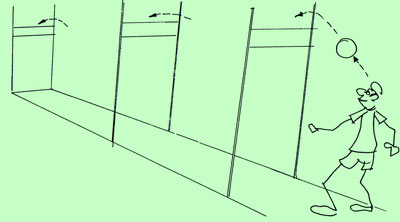 |
|
Image © BBC, 1972 |
| |
The
first game - 'Let It Go to Your Head' - was played in unison and featured two
male competitors from each team and an obstacle course comprised of three
metal frames, similar to those used in rugby, each with a horizontal pole set
at approximately 8ft (2.43m) from the ground. On the whistle, the first
competitor had to throw a ball up in the air and then keep it aloft using only
his head. He then had to walk down the course and head the ball over each the
horizontal bars whilst he passed underneath them. At the end of the course,
the ball had to be deposited into a container. Once he had completed the
course, or his essay had been deemed as finished (if the ball touched the
ground), the second competitor then had to commence his run. The game then had
to be repeated throughout. The balls had to remain in the air at all times and
any ball touched by a competitor’s hand or feet would not be counted. The team
depositing the greater number of footballs during the time allowed would be
declared the winners.
Game 2 - Seesaw Dribble
| |
|
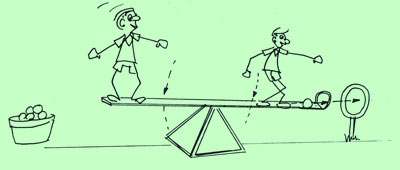 |
|
Image © BBC, 1972 |
| |
The
second game - 'Seesaw Dribble' - was played individually and featured two male
competitors from each team and a large seesaw with a ring attached to one end.
On the ground at one end of the seesaw was a supply of footballs whilst at the
other there was a large ring protruding from the ground, set at 3ft (0.91m) in
front of the game. On the whistle, the two competitors had to work together to
counterweight the seesaw. The first competitor then had to move to his end of
the seesaw and collect a ball. He then had to place it on the seesaw and
dribble it to his team-mate. Once handed over, the two of them had to again
counterweight the seesaw in order for the ring on the board to line up with
the one protruding from the ground. Once completed, the second competitor then
had to shoot the ball through both rings. The game then had to be repeated
throughout. The team scoring the greater number of footballs through both
rings during permitted time would be declared the winners.
|
Comments:
An almost exact copy of this game featured in the 1975 It’s
A Cup Final Knockout, but on that occasion was entitled ‘Seesaw Football’.
|
Game 3 - Hit the Holes
| |
|
 |
|
Image © BBC, 1972 |
| |
The
third game - 'Hit the Holes' - was played individually and featured two
competitors (one male and one female) from each team and an inclined ramp with
five football-sized holes of differing values. On the whistle, the female
competitor had to place a football on the ground in order for the male
competitor to kick it towards and ultimately up the ramp to score. After each
kick, a new ball had to be placed on the ground and the game repeated
throughout. The values of the holes closest to the ground were 1pt (to the
right) and 2pts (to the left), the centrally placed hole was valued at 3pts
and the two uppermost holes were valued at 4pts (to the right) and 5pts (to
the left). The team accumulating the greater number of points during the
permitted time would be declared the winners.
Game 4 - Would You Like
Chips with That?
| |
|
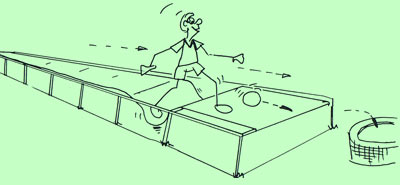 |
|
Image © BBC, 1972 |
| |
The
fourth game - 'Would You Like Chips with That?' - was played in unison and
featured two male competitors from each team and a canvas belt placed on a
metal frame. On the whistle, the first competitor had to dribble a football
along the belt to a solid platform at the end of the course. He then had to
‘chip’ the football into a container located on the ground. Once completed,
the second competitor then had to begin his essay. The game then had to be
repeated throughout. Only balls that remained in the container would be
counted. The team ‘chipping’ the greater number of footballs into their
container within the permitted time would be declared the winners.
Game 5 - Shoot the Hoops
| |
|
 |
|
Image © BBC, 1972 |
| |
The
fifth game - 'Shoot the Hoops' - was played individually and featured six
competitors (three males and three females) from each team in total and three
large rings hanging down from scaffold along the course. Under each ring was a
sliding canvas carpet laid out on the ground which would be operated back and
forth by the opposition team members. On the whistle, the first competitor had
to collect a football and make his / her way across the canvas carpet and hurl
the ball upwards through the first ring and catch it on its descent. If
successful, they then had to do likewise with the second and third rings.
After completion, the ball then had to be deposited into a basketball net at
the far end of the course. The competitor then had to return back to the start
and the game then had to be repeated throughout by the other team members. Any
ball that fell to the ground would not be counted and would mark the end of
that competitor’s essay. The team depositing the greater number of footballs
in the net at the end of permitted time would be declared the winners.
|
Comments:
Despite appearances perhaps suggested by the illustration
of the game, 'Shoot the Hoops' was played on the flat and not an incline.
|
Game 6 - Spinning Shots
| |
|
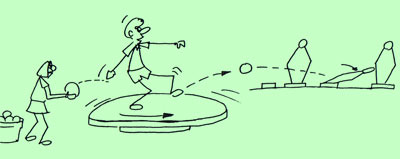 |
|
Image © BBC, 1972 |
| |
The
sixth and penultimate game - 'Spinning Shots' - was played individually over
two heats and featured two competitors (one male and one female) from each
team and a spinning turntable. In front of the game were a number of wooden
cut-out targets. On the first whistle, the turntable on which the male
competitor was located was set in motion. On the sound of a second whistle,
the female had to roll a football to her team-mate and he had to keep control
of it. Whilst remaining on the turntable, he then had to kick the ball towards
the figures in order to knock them down. The game then had to be repeated
throughout. The team knocking over the greater number of targets within
permitted would be declared the winners.
Game 7 - Pass Me the Ball!
| |
|
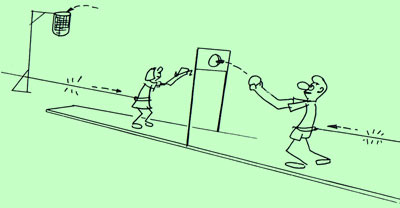 |
|
Image © BBC, 1972 |
| |
The
seventh and final game - 'Pass Me the Ball!' - was played in unison and
featured two competitors (one male and one female) from each team and a tall,
hurdle-like metal frame with a hole just larger than a football located at the
centre of the course. At one end of the course there was a container
containing footballs whilst at the other there was a basketball net. The two
competitors were standing at opposite ends of the course and each tethered by
a strong elastic rope. On the whistle, the male competitor had to collect a
football and then run up the course whilst the female competitor did the same
from the opposite end. When they reached the middle of the course, the male
then had to pass the ball through the hole in the hurdle in order for the
female to receive it. If successful, she then had to return to her end of the
course and throw the ball into the net. The game then had to be repeated
throughout. It should be noted that the competitors’ task was made that more
difficult by the elastic ropes, which were designed to pull taut and hinder
their progress the closer they got to the middle of the course. The team
depositing the greater number of balls into their net would be declared the
winners. |
|
Additional Information |
|
This edition of It’s a Cup Final Knockout was recorded on the day after
the main Domestic It’s a Knockout programme at the same venue (Heat 2).
The programme did not commence recording until 5.30pm.
Stoke City footballers Gordon Banks and George Eastham came
along but divided their support between the two teams. Their team had been beaten by
Arsenal in two consecutive FA Cup semi-finals in 1971 and 1972!
Leeds United F.C.'s win in It's A Cup Final Knockout was
repeated in the 1972 F.A. Cup Final at Wembley Stadium. The match, which
kicked off at 3.00pm on Saturday 6th May, was won 1-0 by Leeds, with Allan
Clarke scoring the decisive goal in the 53rd minute. |
|
Made
in Colour • This programme does not exist in the BBC Archives |
|
|
|
JSFnetGB Series Guide pages researched by
Neil Storer and
Alan Hayes
with Ischa Bijl, Julien Dessy, Sébastien Dias, David Hamilton, Denis Kirsanov, Paul Leaver, Philippe Minet,
Christos Moustakas, David Laich Ruiz, Marko Voštan and JSFnet Websites |
|
|